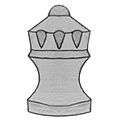Mann (chess)
A mann or man is a fairy chess piece often used in chess variants. It moves like a king, but is not otherwise treated as one (i.e., it has no royal power).[1] In diagrams in this article, the mann is represented by an inverted king. Chess moves in this article use M as notation for the mann.

Movement
The mann moves as a king in chess (one square in any direction) but is otherwise treated as a normal chess piece (i.e. can be captured; is not subject to check or checkmate). It is simply a fused compound between the Ferz, and the Wazir.
| a | b | c | d | e | f | g | h | ||
| 8 |  | 8 | |||||||
| 7 | 7 | ||||||||
| 6 | 6 | ||||||||
| 5 | 5 | ||||||||
| 4 | 4 | ||||||||
| 3 | 3 | ||||||||
| 2 | 2 | ||||||||
| 1 | 1 | ||||||||
| a | b | c | d | e | f | g | h | ||
Value
A mann is approximately equal in strength and value to a knight, generally. Often it takes a few moves to get the mann properly developed in the opening. It is effective at close proximity, where its striking power is considerable. Although it is rather slow, the mann is excellent at both attacking and defending nearby pieces and pawns, similar to the king (Ward 1996:13). The mann reaches its peak strength during the endgame, in which its value is slightly more than a knight, despite being slightly less than a knight in the opening.[2] It is possible to force checkmate with a mann and a king against a lone enemy king. Since the enemy king cannot move to attack either, it is quite easy to box the king into a corner.
History

.jpg)
The mann is one of the most simply described chess pieces and as such has a long history and has gone by many names.[lower-alpha 1] A similar piece was described c. 950 in a form of chess on a 10×10 board and called a dabbaba.[1] The mann has been used since at least the 12th century in Courier chess, and continued to be played in this game for at least six hundred years.[3] Many chess variants have used the mann, for example these modern variants:
- Chess on an infinite plane, as guard
- Quatrochess, as mann
- Roman chess, as archer or chariot
- Knightmate, as commoner
Examples
Each mann is represented by an inverted king in the following examples.
| a | b | c | d | e | f | g | h | ||
| 8 |  | 8 | |||||||
| 7 | 7 | ||||||||
| 6 | 6 | ||||||||
| 5 | 5 | ||||||||
| 4 | 4 | ||||||||
| 3 | 3 | ||||||||
| 2 | 2 | ||||||||
| 1 | 1 | ||||||||
| a | b | c | d | e | f | g | h | ||
| a | b | c | d | e | f | g | h | i | j | |||
| 10 | 10 | |||||||||||
| 9 | 9 | |||||||||||
| 8 | 8 | |||||||||||
| 7 | 7 | |||||||||||
| 6 | 6 | |||||||||||
| 5 | 5 | |||||||||||
| 4 | 4 | |||||||||||
| 3 | 3 | |||||||||||
| 2 | 2 | |||||||||||
| 1 | 1 | |||||||||||
| a | b | c | d | e | f | g | h | i | j |
Notes
- Names including: Man (in Courier chess), der Mann (im Kurierschach), Rath, Counsellor, Sage.
References
- Hooper & Whyld (1996), p. 244. Mann.
- Betza, Ralph. "The WF (or Commoner)". The Chess Variant Pages.
- "Courier chess". The Saint Thomas guild. June 21, 2014.
Bibliography
- Dickins, Anthony (1971) [Corrected repub. of 1969 2nd ed., The Q Press, Richmond, Surrey, England]. A Guide to Fairy Chess. New York: Dover Publications Inc. ISBN 0-486-22687-5.
- Hooper, David; Whyld, Kenneth (1996) [First pub. 1992]. The Oxford Companion to Chess (2nd ed.). Oxford University Press. ISBN 0-19-280049-3.
- Ward, Chris (1996). Endgame Play. Batsford. ISBN 0-7134-7920-5.
External links
- Roman Chess brief overview
- Knightmate brief overview